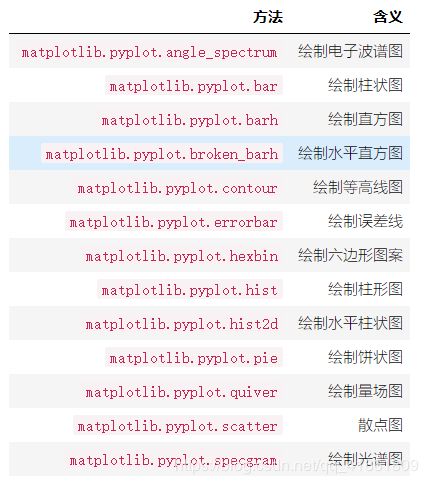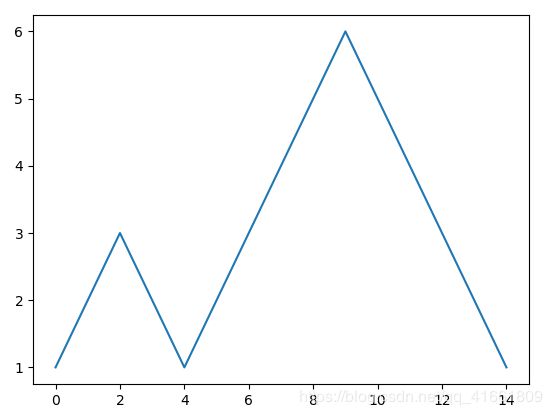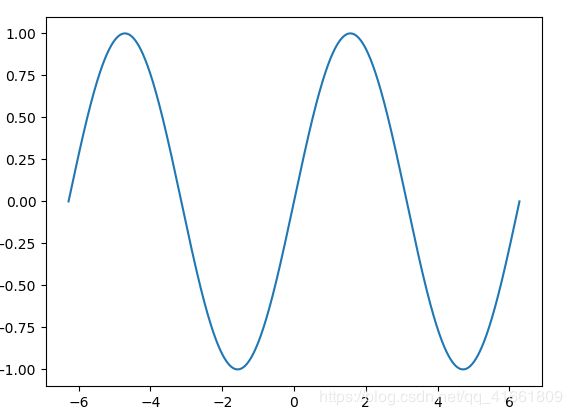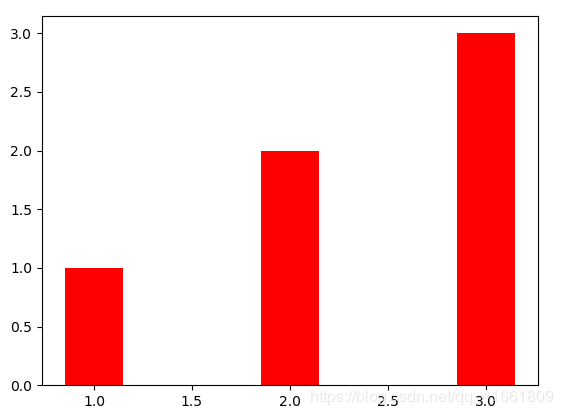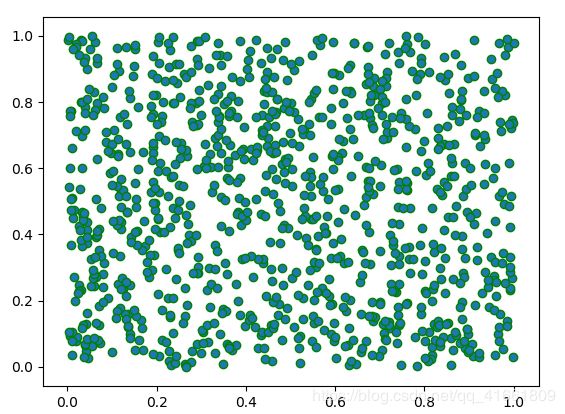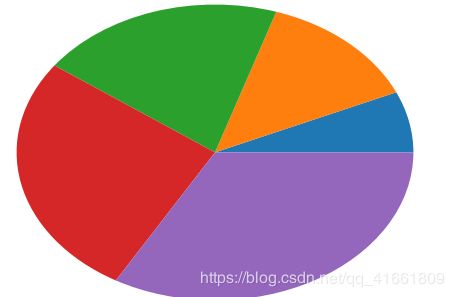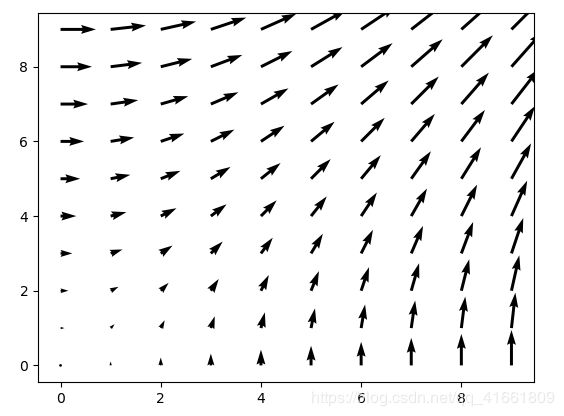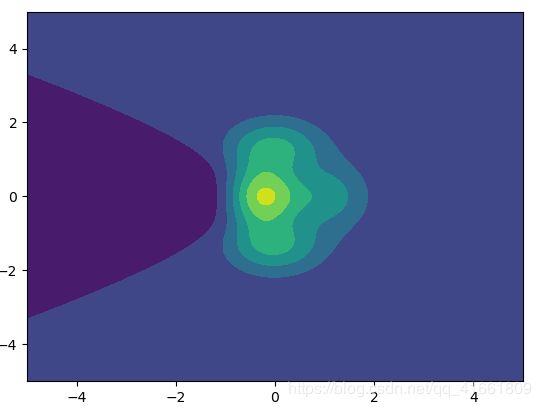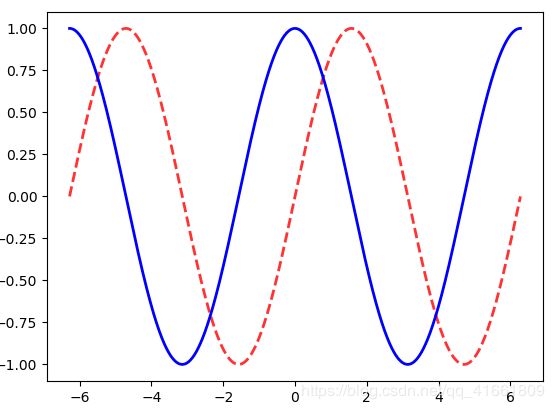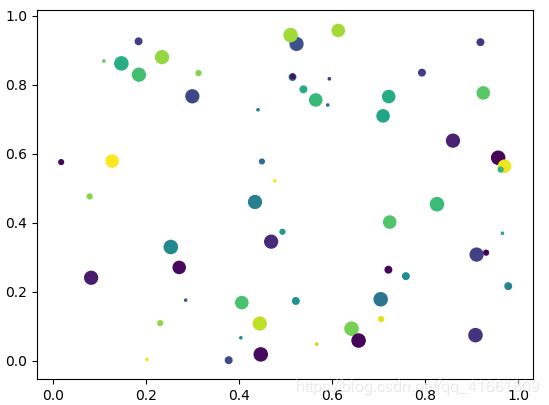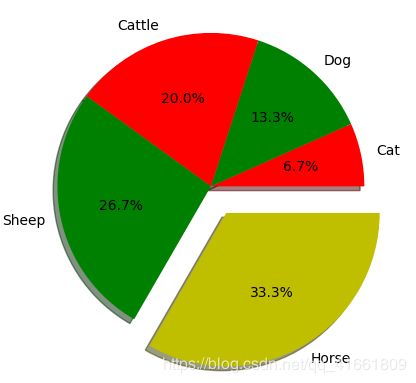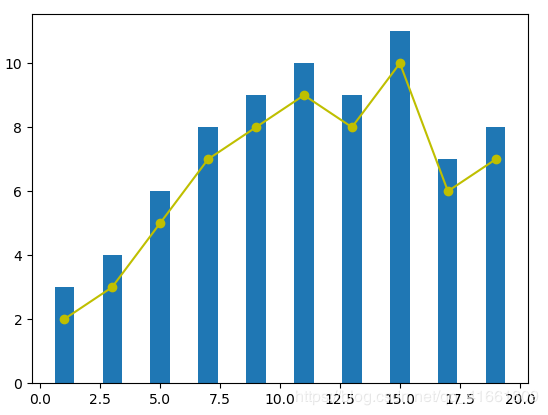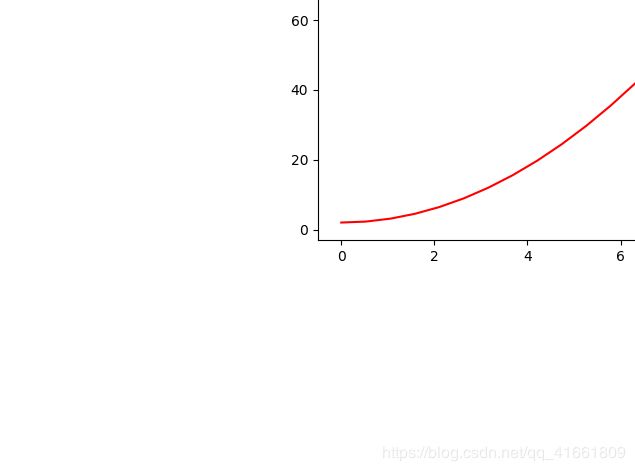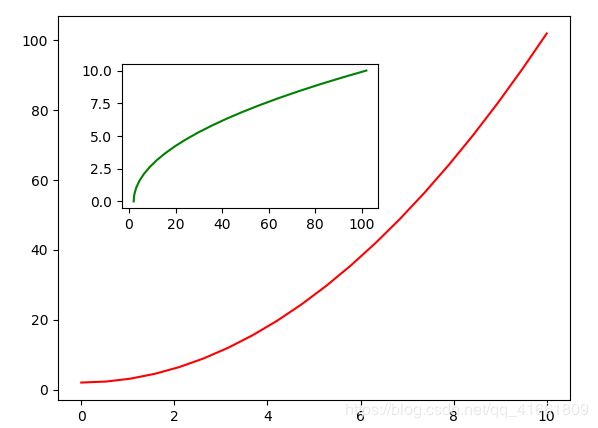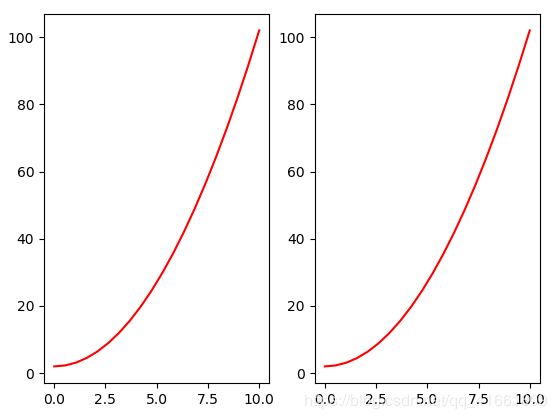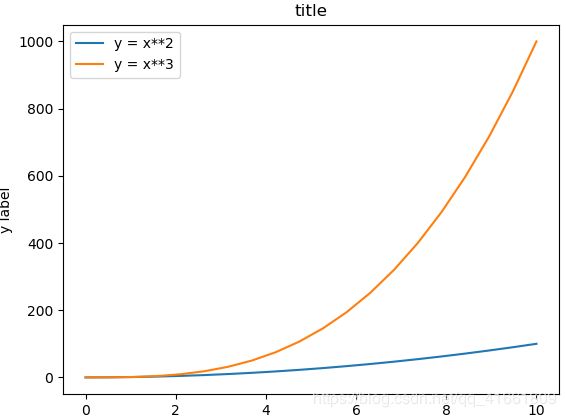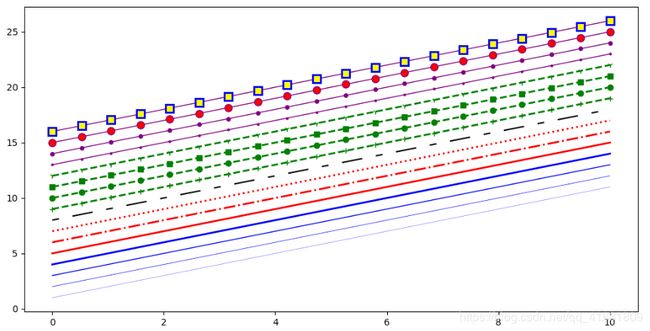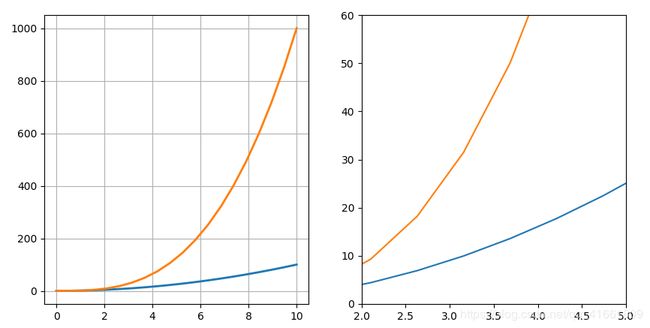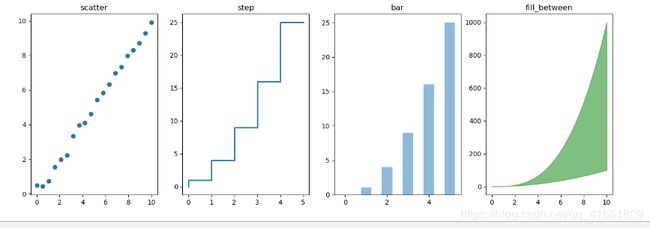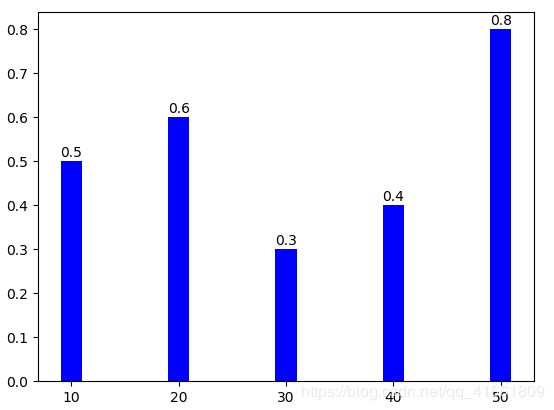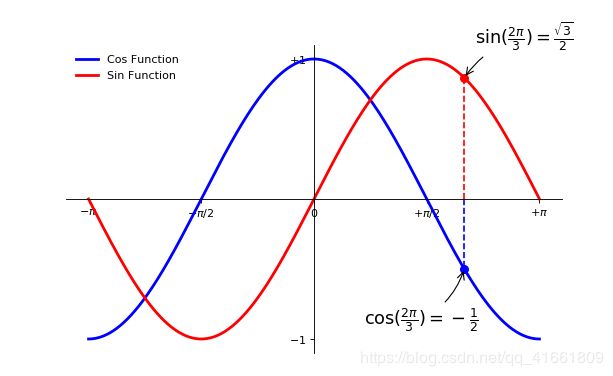Python -- matplotlib 数据绘图基础(二维图形)
from matplotlib import pyplot as plt (1) 折线图
plt.plot([1, 2, 3, 2, 1, 2, 3, 4, 5, 6, 5, 4, 3, 2, 1])
plt.show()
`matplotlib.pyplot.plot(*args, **kwargs)` 方法严格来讲可以绘制线形图或者样本标记。其中,`*args` 允许输入单个 y 值或 x, y值。
(2) 正弦曲线图
X = np.linspace(-2*np.pi,2*np.pi,1000)
Y = np.sin(X)
plt.plot(X,Y)
(3) 柱形图
# 柱形图
plt.bar([1, 2, 3], [1, 2, 3],width=0.3,color='red')
(4)散点图
#散点图
# X,y 的坐标均有 numpy 在 0 到 1 中随机生成 1000 个值
X = np.random.ranf(1000)
y = np.random.ranf(1000)
# 向方法中 `*args` 输入 X,y 坐标
plt.scatter(X, y,edgecolors='green')(5)饼状图
# 饼状图
plt.pie([1,2,3,4,5])(6) 量场图 , 就是由向量组成的图像,在气象学等方面被广泛应用。从图像的角度来看,量场图就是带方向的箭头符号。
X, y = np.mgrid[0:10, 0:10]
plt.quiver(X, y)(7) 等高线图
# 生成网格矩阵
x = np.linspace(-5, 5, 500)
y = np.linspace(-5, 5, 500)
X, Y = np.meshgrid(x, y)
# 等高线计算公式
Z = (1 - X / 2 + X ** 3 + Y ** 4) * np.exp(-X ** 2 - Y ** 2)
plt.contourf(X, Y, Z)定义图形样式
上面,我们绘制了简单的基础图形,但这些图形都不美观。你可以通过更多的参数来让图形变得更漂亮。
二维线性图 比较常用的一些参数 (详细-> 参数) :
| 参数 | 含义 |
|---|---|
alpha= |
设置线型的透明度,从 0.0 到 1.0 |
color= |
设置线型的颜色 |
fillstyle= |
设置线型的填充样式 |
linestyle= |
设置线型的样式 |
linewidth= |
设置线型的宽度 |
marker= |
设置标记点的样式 |
| …… | …… |
(1) 三角函数图像
# 在 -2PI 和 2PI 之间等间距生成 1000 个值,也就是 X 坐标
X = np.linspace(-2 * np.pi, 2 * np.pi, 1000)
# 计算 sin() 对应的纵坐标
y1 = np.sin(X)
# 计算 cos() 对应的纵坐标
y2 = np.cos(X)
# 向方法中 `*args` 输入 X,y 坐标
plt.plot(X, y1, color='r', linestyle='--', linewidth=2, alpha=0.8)
plt.plot(X, y2, color='b', linestyle='-', linewidth=2)(2) 散点图 (官方参数网址)
| 参数 | 含义 |
|---|---|
s= |
散点大小 |
c= |
散点颜色 |
marker= |
散点样式 |
cmap= |
定义多类别散点的颜色 |
alpha= |
点的透明度 |
edgecolors= |
散点边缘颜色 |
# 生成随机数据
x = np.random.rand(100)
y = np.random.rand(100)
colors = np.random.rand(100)
size = np.random.normal(50, 60, 10)
plt.scatter(x, y, s=size, c=colors) # 绘制散点图(3) 饼状图 通过 matplotlib.pyplot.pie() 绘出。我们也可以进一步设置它的颜色、标签、阴影等各类样式。
# 饼状图
label = 'Cat', 'Dog', 'Cattle', 'Sheep', 'Horse' # 各类别标签
color = 'r', 'g', 'r', 'g', 'y' # 各类别颜色
size = [1, 2, 3, 4, 5] # 各类别占比
explode = (0, 0, 0, 0, 0.2) # 各类别的偏移半径
# 绘制饼状图
plt.pie(size, colors=color, explode=explode,
labels=label, shadow=True, autopct='%1.1f%%')
# 饼状图呈正圆
plt.axis('equal')
组合图形样式
x = [1, 3, 5, 7, 9, 11, 13, 15, 17, 19]
y_bar = [3, 4, 6, 8, 9, 10, 9, 11, 7, 8]
y_line = [2, 3, 5, 7, 8, 9, 8, 10, 6, 7]
plt.bar(x, y_bar)
plt.plot(x, y_line, '-o', color='y')定义图形位置
在图形的绘制过程中,你可能需要调整图形的位置,或者把几张单独的图形拼接在一起。此时,我们就需要引入 plt.figure 图形对象了。
x = np.linspace(0, 10, 20) # 生成数据
y = x * x + 2
fig = plt.figure() # 新建图形对象
axes = fig.add_axes([0.5, 0.5, 0.8, 0.8]) # 控制画布的左, 下, 宽度, 高度
axes.plot(x, y, 'r')x = np.linspace(0, 10, 20) # 生成数据
y = x * x + 2
fig = plt.figure() # 新建画板
axes1 = fig.add_axes([0.1, 0.1, 0.8, 0.8]) # 大画布
axes2 = fig.add_axes([0.2, 0.5, 0.4, 0.3]) # 小画布
axes1.plot(x, y, 'r') # 大画布
axes2.plot(y, x, 'g') # 小画布在这里,figure 相当于绘画用的画板,而 axes 则相当于铺在画板上的画布。我们将图像绘制在画布上,于是就有了 plot,set_xlabel 等操作。
借助于图形对象,我们可以实现大图套小图的效果。
上面的绘图代码中, add_axes() 方法向我们设置的画板 figure 中添加画布 axes。在 Matplotlib 中,还有一种添加画布的方式,那就是 plt.subplots(),它和 axes 都等同于画布。
fig, axes = plt.subplots()
axes.plot(x, y, 'r')借助于 plt.subplots(),我们就可以实现子图的绘制,也就是将多张图按一定顺序拼接在一起。
x = np.linspace(0, 10, 20) # 生成数据
y = x * x + 2
fig, axes = plt.subplots(nrows=1, ncols=2) # 子图为 1 行,2 列
for ax in axes:
ax.plot(x, y, 'r')通过设置 plt.subplots 的参数,可以实现调节画布尺寸和显示精度。
fig, axes = plt.subplots(
figsize=(16, 9), dpi=50) # 通过 figsize 调节尺寸, dpi 调节显示精度
axes.plot(x, y, 'r')规范绘图方法
首先,任何图形的绘制,都建议通过 plt.figure() 或者 plt.subplots() 管理一个完整的图形对象。而不是简单使用一条语句,例如 plt.plot(...) 来绘图。
添加图标题、图例
绘制包含图标题、坐标轴标题以及图例的图形,举例如下:
x = np.linspace(0, 10, 20) # 生成数据
y = x * x + 2
fig, axes = plt.subplots()
axes.set_xlabel('x label') # 横轴名称
axes.set_ylabel('y label')
axes.set_title('title') # 图形名称
axes.plot(x, x**2)
axes.plot(x, x**3)
axes.legend(["y = x**2", "y = x**3"], loc=0) # 图例
图例中的 loc 参数标记图例位置,1,2,3,4 依次代表:右上角、左上角、左下角,右下角;0 代表自适应
线型、颜色、透明度
fig, axes = plt.subplots()
axes.plot(x, x+1, color="red", alpha=0.8)
axes.plot(x, x+2, color="#1155dd")
axes.plot(x, x+3, color="#15cc55")而对于线型而言,除了实线、虚线之外,还有很多丰富的线型可供选择。
fig, ax = plt.subplots(figsize=(12, 6))
# 线宽
ax.plot(x, x+1, color="blue", linewidth=0.25)
ax.plot(x, x+2, color="blue", linewidth=0.50)
ax.plot(x, x+3, color="blue", linewidth=1.00)
ax.plot(x, x+4, color="blue", linewidth=2.00)
# 虚线类型
ax.plot(x, x+5, color="red", lw=2, linestyle='-')
ax.plot(x, x+6, color="red", lw=2, ls='-.')
ax.plot(x, x+7, color="red", lw=2, ls=':')
# 虚线交错宽度
line, = ax.plot(x, x+8, color="black", lw=1.50)
line.set_dashes([5, 10, 15, 10])
# 符号
ax.plot(x, x + 9, color="green", lw=2, ls='--', marker='+')
ax.plot(x, x+10, color="green", lw=2, ls='--', marker='o')
ax.plot(x, x+11, color="green", lw=2, ls='--', marker='s')
ax.plot(x, x+12, color="green", lw=2, ls='--', marker='1')
# 符号大小和颜色
ax.plot(x, x+13, color="purple", lw=1, ls='-', marker='o', markersize=2)
ax.plot(x, x+14, color="purple", lw=1, ls='-', marker='o', markersize=4)
ax.plot(x, x+15, color="purple", lw=1, ls='-',
marker='o', markersize=8, markerfacecolor="red")
ax.plot(x, x+16, color="purple", lw=1, ls='-', marker='s', markersize=8,
markerfacecolor="yellow", markeredgewidth=2, markeredgecolor="blue")画布网格、坐标轴范围
fig, axes = plt.subplots(1, 2, figsize=(10, 5))
# 显示网格
axes[0].plot(x, x**2, x, x**3, lw=2)
axes[0].grid(True)
# 设置坐标轴范围
axes[1].plot(x, x**2, x, x**3)
axes[1].set_ylim([0, 60])
axes[1].set_xlim([2, 5])除了折线图,Matplotlib 还支持绘制散点图、柱状图等其他常见图形。下面,我们绘制由散点图、梯步图、条形图、面积图构成的子图。
n = np.array([0, 1, 2, 3, 4, 5])
# 1 行 4 列
fig, axes = plt.subplots(1, 4, figsize=(16, 5))
axes[0].scatter(x, x + 0.25*np.random.randn(len(x)))
axes[0].set_title("scatter")
axes[1].step(n, n**2, lw=2)
axes[1].set_title("step")
axes[2].bar(n, n**2, align="center", width=0.5, alpha=0.5)
axes[2].set_title("bar")
axes[3].fill_between(x, x**2, x**3, color="green", alpha=0.5)
axes[3].set_title("fill_between")
图形标注方法
当我们绘制一些较为复杂的图像时,阅读对象往往很难全面理解图像的含义。而此时,图像标注往往会起到画龙点睛的效果。图像标注,就是在画面上添加文字注释、指示箭头、图框等各类标注元素。
Matplotlib 中,文字标注的方法由 matplotlib.pyplot.text() 实现。最基本的样式为 matplotlib.pyplot.text(x, y, s),其中 x, y 用于标注位置定位,s 代表标注的字符串。除此之外,你还可以通过 fontsize= , horizontalalignment= 等参数调整标注字体的大小,对齐样式等。
下面,我们举一个对柱形图进行文字标注的示例。
fig, axes = plt.subplots()
x_bar = [10, 20, 30, 40, 50] # 柱形图横坐标
y_bar = [0.5, 0.6, 0.3, 0.4, 0.8] # 柱形图纵坐标
bars = axes.bar(x_bar, y_bar, color='blue', label=x_bar, width=2) # 绘制柱形图
for i, rect in enumerate(bars):
x_text = rect.get_x() # 获取柱形图横坐标
y_text = rect.get_height() + 0.01 # 获取柱子的高度并增加 0.01
plt.text(x_text, y_text, '%.1f' % y_bar[i]) # 标注文字除了文字标注之外,还可以通过 matplotlib.pyplot.annotate() 方法向图像中添加箭头等样式标注。接下来,我们向上面的例子中增添一行增加箭头标记的代码。
x_bar = [10, 20, 30, 40, 50] # 柱形图横坐标
y_bar = [0.5, 0.6, 0.3, 0.4, 0.8] # 柱形图纵坐标
fig, axes = plt.subplots()
bars = axes.bar(x_bar, y_bar, color='blue', label=x_bar, width=2) # 绘制柱形图
for i, rect in enumerate(bars):
x_text = rect.get_x() # 获取柱形图横坐标
y_text = rect.get_height() + 0.01 # 获取柱子的高度并增加 0.01
plt.text(x_text, y_text, '%.1f' % y_bar[i]) # 标注文字
# 增加箭头标注
plt.annotate('Min', xy=(32, 0.3), xytext=(36, 0.3),
arrowprops=dict(facecolor='black', width=1, headwidth=7))上面的示例中,xy=() 表示标注终点坐标,xytext=() 表示标注起点坐标。在箭头绘制的过程中,arrowprops=() 用于设置箭头样式,facecolor= 设置颜色,width= 设置箭尾宽度,headwidth= 设置箭头宽度,可以通过 arrowstyle= 改变箭头的样式。
实战 :
参考答案
# -----------------------------------------------------------------------------
# Copyright (c) 2015, Nicolas P. Rougier. All Rights Reserved.
# Distributed under the (new) BSD License. See LICENSE.txt for more info.
# -----------------------------------------------------------------------------
import numpy as np
import matplotlib.pyplot as plt
plt.figure(figsize=(8, 5), dpi=80)
ax = plt.subplot(111)
ax.spines['right'].set_color('none')
ax.spines['top'].set_color('none')
ax.xaxis.set_ticks_position('bottom')
ax.spines['bottom'].set_position(('data', 0))
ax.yaxis.set_ticks_position('left')
ax.spines['left'].set_position(('data', 0))
X = np.linspace(-np.pi, np.pi, 256, endpoint=True)
C, S = np.cos(X), np.sin(X)
plt.plot(X, C, color="blue", linewidth=2.5, linestyle="-", label="Cos Function")
plt.plot(X, S, color="red", linewidth=2.5, linestyle="-", label="Sin Function")
plt.xlim(X.min() * 1.1, X.max() * 1.1)
plt.xticks([-np.pi, -np.pi / 2, 0, np.pi / 2, np.pi],
[r'$-\pi$', r'$-\pi/2$', r'$0$', r'$+\pi/2$', r'$+\pi$'])
plt.ylim(C.min() * 1.1, C.max() * 1.1)
plt.yticks([-1, +1],
[r'$-1$', r'$+1$'])
t = 2 * np.pi / 3
plt.plot([t, t], [0, np.cos(t)],
color='blue', linewidth=1.5, linestyle="--")
plt.scatter([t, ], [np.cos(t), ], 50, color='blue')
plt.annotate(r'$\sin(\frac{2\pi}{3})=\frac{\sqrt{3}}{2}$',
xy=(t, np.sin(t)), xycoords='data',
xytext=(+10, +30), textcoords='offset points', fontsize=16,
arrowprops=dict(arrowstyle="->", connectionstyle="arc3,rad=.2"))
plt.plot([t, t], [0, np.sin(t)],
color='red', linewidth=1.5, linestyle="--")
plt.scatter([t, ], [np.sin(t), ], 50, color='red')
plt.annotate(r'$\cos(\frac{2\pi}{3})=-\frac{1}{2}$',
xy=(t, np.cos(t)), xycoords='data',
xytext=(-90, -50), textcoords='offset points', fontsize=16,
arrowprops=dict(arrowstyle="->", connectionstyle="arc3,rad=.2"))
plt.legend(loc='upper left', frameon=False)
plt.show()

